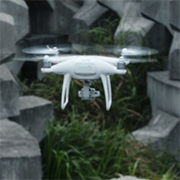Direct Broadcast Drone ID Method Imposes Fewest Burdens, Protects Privacy
DJI, the world’s leader in civilian drones and aerial imaging technology, welcomes today’s release of a Federal Aviation Administration (FAA) committee report on technology to identify drones in flight, clearing the way for drones to be used in new beneficial ways. The report recommends that drones broadcast identifying information to local receivers, which is the “electronic license plate” technology in DJI’s new AeroScope system for identifying airborne drones. This imposes the fewest burdens on drone owners and pilots, while building in protections for their privacy.
The FAA’s Aviation Rulemaking Committee (ARC) for remote identification and tracking of drones, also known as unmanned aircraft systems (UAS), recommended mandatory adoption of a local broadcast mechanism to provide people near the drone with important information – rather than a mandatory internet-based network system that would require all drone flights to be automatically transmitted to a central location and stored in a government database.
DJI separately released a discussion paper on the key conclusions, recommendations and observation in the ARC Report.
Governments around the world are considering proposals to require most drones to be equipped with remote identification capabilities, consistent with the legal frameworks and expectations in each country. Drone pilots should understand how they would be affected by the costs and burdens of different proposals to meet these future requirements. While a networked system would likely force drone pilots to pay for wireless data service on every drone, a local broadcast mechanism imposes the least cost on manufacturers and no cost on drone users.
“Owners and operators have legitimate reasons to keep the locations, dates, and times of their UAS flights private even if that data is not directly associated with [personally identifiable information],” the report states. “The privacy of all individuals (including operators and customers) should be addressed, and privacy should be a consideration during the rulemaking for remote ID and tracking.”
The report establishes a pathway for a remote identification technology to satisfy law enforcement and national security needs while also respecting the rights of drone pilots and protecting their flight data. By showing that authorities can manage their safety and security concerns about drones, the ARC report will assist the FAA to move forward with more far-reaching professional uses of drones, such as flying directly over unprotected people or beyond visual line of sight.
Remote identification technology will also allow authorities to enforce existing laws in the rare cases when someone is accused of doing something illegal with a drone. Providing an enforcement mechanism against clearly illegal behavior will help improve social acceptance of drones, without requiring new laws aimed strictly at drone operations.
The ARC report recommends that drones continually send a unique identifier as well as drone location information, which authorities can correlate with information on drone owners and pilots if necessary. The ARC was chartered in May to recommend ways to remotely identify drones in flight, so law enforcement, homeland security and airport officials can monitor for drone flights in areas where they may pose a safety or security risk. DJI served as one of 74 organizations represented on the committee.
DJI first noted in March that a direct broadcast system is far easier to implement, imposes few burdens on drone operators, and would not force every drone pilot in the United States to centrally report every drone flight to a government database. In October, DJI unveiled its AeroScope system, which broadcasts position and identification information using the drone’s existing command-and-control radio link to any receivers within a range of up to 5 kilometers.
“DJI supports many of the conclusions in the ARC report, understanding that its limited purpose was to describe the needs of security and law enforcement agencies and to recommend the technologies that could meet those needs,” said Brendan Schulman, DJI Vice President for Policy and Legal Affairs, who represented DJI on the ARC. “There is still an important discussion to come about how to balance governmental needs and desires with the burdens, costs, and privacy invasions that could be faced by drone pilots depending on the actual technologies chosen and how they are implemented. Drone pilots and operators were not well-represented in terms of the number of ARC members, and we feel their interests will be expressed in the future rulemaking process that lies ahead.”





